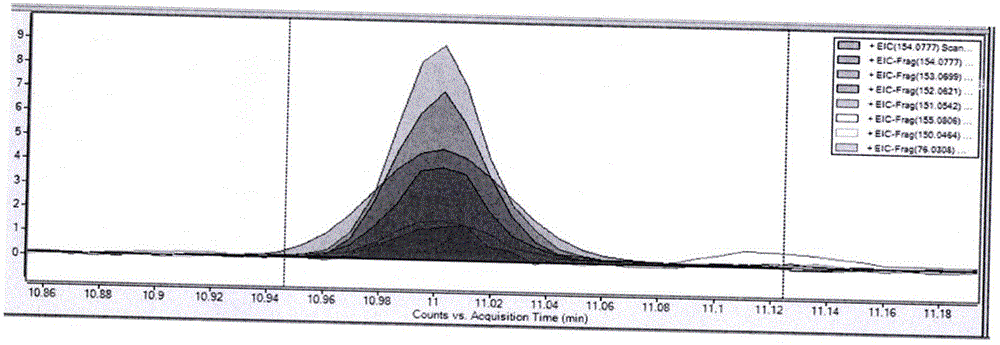GC-Q-TOF/MS detection technology of 708 pesticide residues in legume vegetables
A GC-Q-TOF technology for beans and vegetables, applied in the field of pesticide residue detection, can solve the problems of food safety monitoring loopholes, high prices, and a valid period of only 2-3 years, so as to save detection costs, save costs, and improve work efficiency effect
- Summary
- Abstract
- Description
- Claims
- Application Information
AI Technical Summary
Problems solved by technology
Method used
Image
Examples
Embodiment 1
[0087] This example is used to illustrate the GC-Q-TOF / MS detection method for screening 708 kinds of pesticide residues in legume vegetables provided by the present invention
[0088] (1) The edible part of the bean sample sold in Beijing area was chopped, mixed, sealed, and marked.
[0089](2) Weigh 10g of the above carob sample (accurate to 0.01g), add 40mL of 1% acetic acid in acetonitrile solution to an 80ml centrifuge tube, use a high-speed homogenizer at 13500r / min, homogenize and extract for 1min, add 1g of sodium chloride , 4g of anhydrous magnesium sulfate, shake for 5min, centrifuge at 4200r / min for 5min, take 20mL of the supernatant, concentrate it to about 1mL by rotary evaporation in a water bath at 40°C, and wait for purification.
[0090] (3) in Carbon / NH 2 Add about 2cm high anhydrous sodium sulfate to the column. Rinse the SPE column with 4 mL of acetonitrile + toluene (3+1, v / v) first, and discard the effluent. When the liquid level reaches the top of sodi...
Embodiment 2
[0098] This example is used to illustrate the GC-Q-TOF / MS detection method for screening 708 kinds of pesticide residues in legume vegetables provided by the present invention
[0099] According to the method in Example 1, the pesticide residues in the same batch of beans samples are detected, the difference is that the pretreatment steps are as follows:
[0100] (1) Accurately weigh 10.00g of sample into a centrifuge tube, add 50mL of water, and shake until the sample is fully soaked by water. After freezing for 10 min, pipette 50 mL of acetonitrile into a centrifuge tube, then place the centrifuge tube on a vortex mixer and vibrate at 2000 rpm for 1 min. Keep the centrifuge tube at -10°C for 10 minutes, then add 20g of anhydrous magnesium sulfate, 5g of sodium chloride, 5g of sodium citrate and 2.5g of sodium dihydrogen citrate into the centrifuge tube, and immediately place it on a vortex mixer , shake at 2000rpm for 2min, then centrifuge at 4000rpm for 10min to obtain sup...
Embodiment 3
[0107] This example is used to illustrate the GC-Q-TOF / MS detection method for screening 708 kinds of pesticide residues in legume vegetables provided by the present invention
[0108] The detection of pesticide residues in legume vegetables was carried out according to the method in Example 1, the difference is that the sample was a bean sample in Tianjin area.
[0109] 17 samples of beans sold in the Tianjin area were collected, and 24 kinds of pesticide residues were detected, with a total of 76 frequencies involving 16 samples. The specific results are shown in Table 3.
[0110] table 3
[0111]
[0112] Take wezaling, which has a high detection frequency, as an example, such as image 3 As shown, 4 fragment ions were detected in beans, searched in the database, and compared with Vezalin, the molecular weight deviation scores of the 4 fragment ions were all above 95 points, and the retention time deviation was within 0.008min, the fragment with the highest abundance T...
PUM
| Property | Measurement | Unit |
|---|---|---|
| ion source temperature | aaaaa | aaaaa |
| ion source temperature | aaaaa | aaaaa |
Abstract
Description
Claims
Application Information
 Login to View More
Login to View More - R&D
- Intellectual Property
- Life Sciences
- Materials
- Tech Scout
- Unparalleled Data Quality
- Higher Quality Content
- 60% Fewer Hallucinations
Browse by: Latest US Patents, China's latest patents, Technical Efficacy Thesaurus, Application Domain, Technology Topic, Popular Technical Reports.
© 2025 PatSnap. All rights reserved.Legal|Privacy policy|Modern Slavery Act Transparency Statement|Sitemap|About US| Contact US: help@patsnap.com



